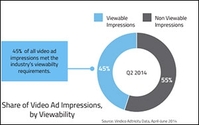 Digital advertising’s viewability
problem is getting bigger when it comes to display ads, and the Media Rating Council
(MRC) standard for video ads -- which went into effect in late June -- doesn't seem to be helping much on the video side of things, either.
Digital advertising’s viewability
problem is getting bigger when it comes to display ads, and the Media Rating Council
(MRC) standard for video ads -- which went into effect in late June -- doesn't seem to be helping much on the video side of things, either.
Here's a quick rundown of the new standards: A video
ad is deemed “viewable” if at least 50% of its pixels are in-view for at least two seconds.
A new report from video ad management platform Vindico says that 45% of all video ad
impressions were viewable from April through June, 2014, which is in line with previous quarters. (Even though the new viewability standards didn’t go into effect until the end of June, Vindico
changed its own definition of “viewable” in April.)
advertisement
advertisement
So in other words, over half (55%) of video ads were not viewable in Q2. In other other words, that’s a lot of
wasted money.
Vindico writes in its report: “Viewability rates remain relatively consistent post two-second standard shift.” Technically, the data from Vindico’s chart was
collected during the gating period of the MRC’s new video viewability standard, so we might be jumping the gun a bit here to say it hasn’t made a difference. Data from Q3 and beyond will
be the real test.
But in truth, would you be all that surprised if the viewability rates hover at or below 50%, even once the “50% in-view for two seconds rule” has been around for
a while? Early indications suggest it may not have as strong an impact as some people hope.